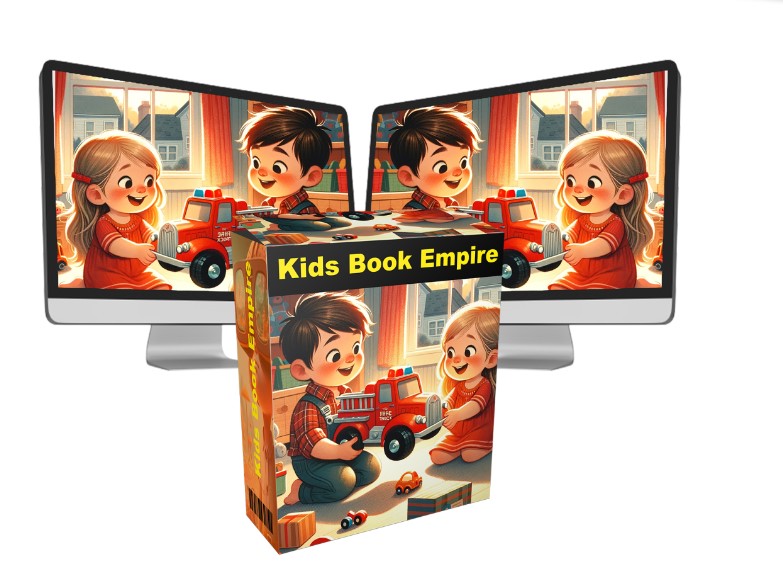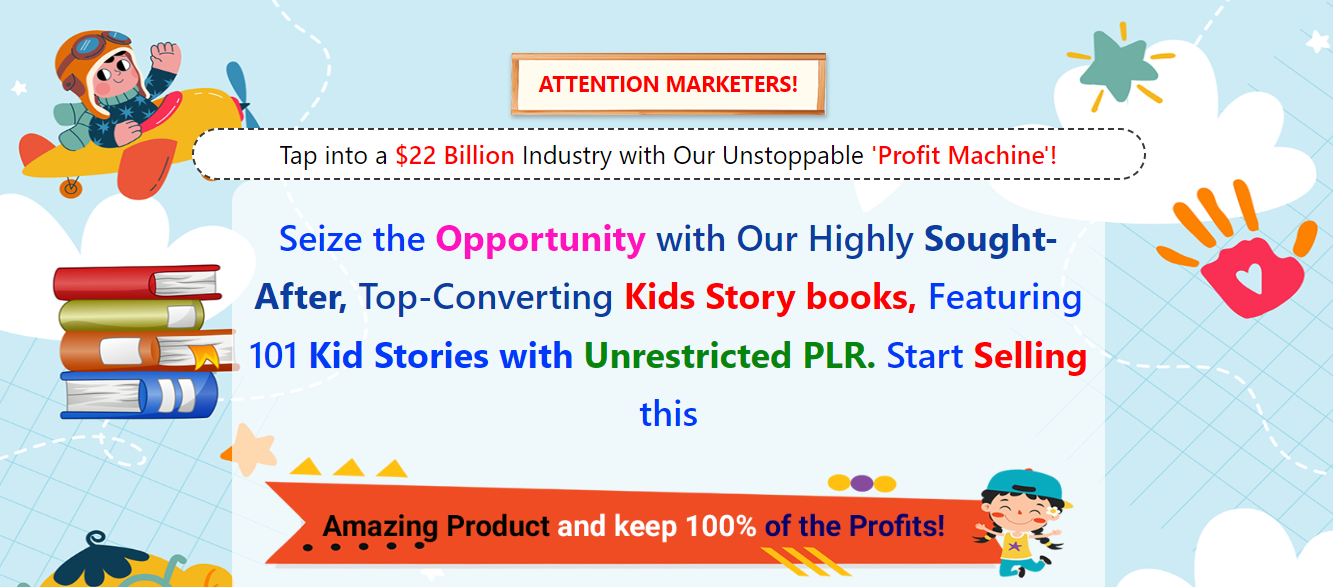Kids Story Books are entertaining and educational tools that ignite a child’s imagination and enhance their language skills. These books incorporate colorful illustrations, engaging characters, and captivating narratives to create an immersive reading experience for young minds.
Whether it’s a classic fairy tale, an adventure-packed tale, or a story with a moral lesson, kids storybooks hold a unique place in a child’s learning journey. They foster creativity, vocabulary development, and critical thinking skills while instilling a love for reading from an early age.
From picture books for toddlers to chapter books for older children, kids storybooks offer a wide range of options to cater to every child’s interests and reading abilities.
Credit: https://webmagnus.com/kidsstory/
Overview:
| Vendor: | Vivek Sharma |
| Product: | Kids Story Books w/ Unrestricted PLR |
| Launch Date: | 2024-Jan-22 |
| Launch Time: | 11:00 EST |
| Front-End Price: | 9.99 |
| Niche: | PLR |
Official Website: CLICK HERE
100% Instant Free Access Here!
Click the button below to get started.
Get Instant Access to Kids Story Books
The Power Of Storytelling
Storytelling has always been a powerful tool that captivates both children and adults. Kids story books have the incredible ability to transport young minds to magical worlds where imaginations run wild and dreams take flight. They have the power to entertain, educate, and inspire, leaving a lasting impact on children’s lives.
Fostering Creativity
Storybooks are a gateway to creativity for children. As they dive into the colorful pages filled with interesting characters and enchanting settings, their own imaginations begin to take shape. Each word and illustration ignites their creativity, allowing them to visualize stories, create their own characters, and even craft their imaginative worlds. By nurturing their creative abilities through storybooks, children can develop innovative thinking skills that will benefit them throughout their lives.
Developing Empathy
Storybooks are not mere entertainment; they also serve as valuable tools for developing empathy in children. When kids immerse themselves in the tales of others, they gain a deeper understanding of different perspectives, experiences, and emotions. These stories allow children to walk in the shoes of the characters they encounter, promoting compassion and empathy. By following the journey of diverse characters, children learn to appreciate differences, develop tolerance, and become more understanding individuals.
Choosing The Right Storybooks
Choosing the right story books for your kids is essential to foster a love for reading and to engage them in meaningful and imaginative adventures. Age-appropriate themes, quality illustrations, and captivating storytelling can make a world of difference in their reading experience. Let’s explore each of these factors in detail.
Age-appropriate Themes
When selecting storybooks for your kids, considering age-appropriate themes is crucial. Books that align with their developmental stage and interests can captivate their attention and enhance their learning experience. Topics such as friendship, family, adventure, animals, and problem-solving are popular choices for younger children.
| Age Group | Age-Appropriate Themes |
|---|---|
| 2-4 years | Colors, shapes, animals, and nursery rhymes |
| 5-7 years | Moral values, fairy tales, superheroes, fantasy |
| 8-10 years | Mystery, identity, friendship, and adventure |
Quality Illustrations
Eye-catching and high-quality illustrations play a vital role in engaging young readers. Books with vibrant colors, detailed drawings, and expressive characters can spark your child’s imagination and make the story come to life. Additionally, illustrations can help children better understand the narrative and connect with the characters and settings.
- Visual appeal
- Enhances comprehension
- Stimulates imagination
- Facilitates emotional connection with characters
Captivating Storytelling
A well-crafted story with an engaging plot and relatable characters can make reading time an exciting and enjoyable experience for your kids. Look for books that have concise and engaging narratives, age-appropriate language, and a suitable pace. Well-developed characters and well-structured storylines can captivate their attention and encourage them to develop good reading habits.
- Engaging plot
- Relatable characters
- Age-appropriate language
- Well-structured storyline
Choosing the right story books for your kids can open up a world of imagination, creativity, and learning. Consider age-appropriate themes, quality illustrations, and captivating storytelling to enhance their reading experience. Remember, the right story can leave a lasting impression and foster a lifelong love for reading in your little ones.
Benefits Of Storytelling For Kids
Benefits of Storytelling for Kids
Storytelling plays a vital role in a child’s overall development. It offers numerous benefits that go beyond simply entertaining. By exposing children to the world of stories, parents and educators can greatly contribute to their language development, cognitive skills, and emotional intelligence.
Language Development
Storybooks are a wonderful tool for nurturing a child’s language skills. When children listen to stories, they are exposed to various sounds, words, and sentence structures that contribute to expanding their vocabulary. Moreover, when they are encouraged to tell a story themselves, it helps improve their communication skills.
Cognitive Skills
Through storytelling, children develop cognitive abilities such as critical thinking, problem-solving, and imagination. As they engage in the plot, characters, and settings of a story, their brain processes different scenarios, enhancing their cognitive development.
Emotional Intelligence
Storybooks provide an excellent platform to cultivate emotional intelligence in children. When kids read about various characters’ emotions and experiences, it helps them understand and empathize with others’ feelings. This, in turn, allows them to manage their emotions effectively.

Credit: storybird.ai
Interactive Reading Techniques
Engage your child in interactive reading techniques with kids’ storybooks. Encouraging them to ask questions, make predictions, and connect the story to their own experiences enhances their comprehension and critical thinking skills. This approach fosters a love for reading while developing their cognitive abilities.
Engaging Dialogues
Engaging dialogues are an effective interactive reading technique that can captivate young readers and make storytime even more enjoyable. By using expressive voices and animated tones, adults can bring the characters to life and create a vivid storytelling experience. Imagine the excitement in your child’s eyes as they hear the playful banter between their favorite storybook heroes!
The key to engaging dialogue lies in the tone and inflection used while reading. For instance, when narrating a conversation between two characters, use different voices to distinguish each one. A deep voice for the wise old wizard and a high-pitched voice for the mischievous elf can make the dialogue more engaging and memorable. By immersing children in the story through lively and expressive dialogues, you can foster their love for reading and make it an interactive adventure.
Acting Out The Characters
Acting out the characters introduces a whole new dimension to storytelling. This technique involves physically embodying the characters and enacting their actions as the story unfolds. Encourage your child to join in the fun by assigning them roles or letting them choose their favorite characters to bring to life.
By physically engaging with the story, children develop a deeper connection to the narrative and its characters. They become active participants, imagining themselves in the story’s world. This not only enhances their comprehension but also sparks their creativity and imagination. Whether they are mimicking a hero’s valiant sword swings or a villain’s dramatic laughter, acting out the characters adds excitement and fun to the reading experience.
A great way to encourage acting out the characters is by using props and costumes. Simple props like hats, capes, or hand puppets can instantly transform your child into a beloved storybook character. Let them unleash their inner actor and watch as their enthusiasm for reading soars.
<<<< 100% Instant Free Access Here >>>>
Nurturing A Love For Reading
Helping children develop a love for reading is one of the greatest gifts we can give them. By fostering a passion for books, we ignite their imagination, expand their knowledge, and open doors to new worlds. In this blog post, we will discuss two key aspects of nurturing a love for reading: creating a reading routine and encouraging imagination.
Creating A Reading Routine
Consistency is key when it comes to creating a reading routine for children. By establishing a daily reading habit, we create a sense of anticipation and excitement around books. Here are a few ways to incorporate reading into your child’s routine:
- Set aside a specific time each day for reading, such as before bedtime or after dinner.
- Create a cozy reading nook in your child’s room or a designated area in your home where they can retreat into the pages of a book.
- Make reading a family affair by engaging in a group reading session. Take turns reading aloud, or choose a book to read together.
By making reading a regular part of their daily lives, children will develop a deep appreciation for books and the written word.
Encouraging Imagination
One of the magical aspects of reading is its ability to spark imagination. Through books, children can embark on exciting adventures, meet extraordinary characters, and explore fantastical worlds. Here’s how you can foster imagination through reading:
- Choose books that are rich in descriptive language and vivid imagery. These types of books allow children to visualize and create mental images of the story.
- Encourage your child to engage in imaginative play inspired by the books they read. They can reenact scenes from their favorite stories or create their own stories using the characters and settings they’ve encountered.
- Ask open-ended questions about the book to stimulate critical thinking and encourage your child to imagine what might happen next or how they would feel in a certain situation.
By nurturing the power of imagination, we cultivate a lifelong love for reading and a creative mindset in our children.

Credit: in.pinterest.com
Frequently Asked Questions Of Kids Story Books
What Is the Most Famous Kids Story?
The most famous kids story is likely “The Little Prince” by Antoine de Saint-Exupéry, captivating readers with its timeless and imaginative tale.
What Is the Most Popular Children’s Book?
The most popular children’s book is “Harry Potter and the Philosopher’s Stone” by J. K. Rowling. It has captivated millions of young readers worldwide. Its magical storyline and relatable characters have made it a beloved favorite for children of all ages.
What Books Should 7-Year-Olds Read?
7-year-olds can enjoy books like “Charlotte’s Web,” “Magic Tree House” series, “Diary of a Wimpy Kid,” and “Junie B. Jones. ” These books offer engaging stories and age-appropriate themes to enhance their reading skills and imagination.
What Are the 4 Types of Stories for Kids?
The four types of stories for kids are: fairy tales, fables, nursery rhymes, and folktales. These stories are popular in children’s literature and help children learn important lessons while entertaining them.
Conclusion
Kids storybooks play a crucial role in a child’s development by promoting literacy and nurturing imagination. By exploring different worlds and characters, children can cultivate empathy and critical thinking skills. With engaging and age-appropriate content, these books offer endless opportunities for learning and entertainment.
Encouraging a love for storytelling from a young age can foster a lifelong passion for reading.







